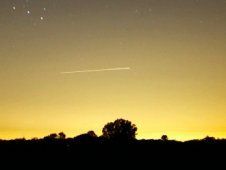
If you missed this weekend's night time speculator that was the 2012 Orionid meteor shower, there may be another opportunity for you to catch the light display.
The Orionid Meteor Shower 2012 is active from Oct. 3, Nov. 13.
The best time to view the Orionid Meteor Shower 2012 is one to two hours before dawn.
If you are in the Eastern Time Zone, it will be above you at 5 a.m. EDT. If you are in the Pacific Time Zone, it will be above you at 5 a.m. PDT.
According to NASA, Orionids appear every year around this time when Earth orbits through an area of space littered with debris from the ancient comet. Normally, the shower produces 20 or so meteors per hour. The past few years, however, have been much better than usual.
"Earth is passing through a stream of debris from Halley's Comet, the source of the Orionids," Bill Cooke of NASA's Meteoroid Environment Office said. "Flakes of comet dust hitting the atmosphere should give us dozens of meteors per hour. Since 2006, the Orionids have been one of the best showers of the year, with counts in some years up to 60 or more meteors per hour."
According to Discovery, if you plan to watch the Orionids with your own eyes, there are three important things you should do:
Find a dark sky:While the Orionids have been a fairly dependable meteor shower in recent years, the best viewing conditions are in places far from city lights, which can hamper your view.
Dress warmly:You may want to take your time observing the Orionids, so a warm jacket to ward off the predawn chill may prove useful.
Get comfortable:A reclining lawn chair or other comfy seat can help ease neck strain from constantly looking up for a glimpse of meteors. Add a blanket and a cup of hot chocolate and you've got cozy meteor-hunting night out.
© 2025 Latin Times. All rights reserved. Do not reproduce without permission.




